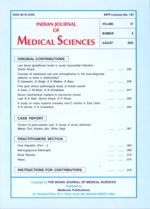
|
Indian Journal of Medical Sciences
Medknow Publications on behalf of Indian Journal of Medical Sciences Trust
ISSN: 0019-5359
EISSN: 0019-5359
Vol. 61, No. 8, 2007, pp. 441-447
|
 Bioline Code: ms07072
Bioline Code: ms07072
Full paper language: English
Document type: Research Article
Document available free of charge
|
|
|
Indian Journal of Medical Sciences, Vol. 61, No. 8, 2007, pp. 441-447
| en |
The incidence and clinical characteristics of the immune phase eye disease in treated cases of human leptospirosis
Pappachan, Joseph M.; Mathew, Sheela; Thomas, Baby; Renjini, K.; Scaria, Charles K. & Shukla, Jyoti
Abstract
Background: Uveitis is increasingly being reported from south India following epidemics of leptospirosis. The incidence of eye involvement in treated patients has not been investigated properly in prospective studies.
Aims :To determine the incidence, clinical spectrum and risk factors for Leptospiral uveitis in antibiotic-treated patients.
Settings and Design: A prospective cohort study conducted among the patients treated for leptospirosis at Calicut Medical College between July and November 2002 and a seroprevalence study among sewage workers.
Materials And Methods: As many as 360 patients admitted with suspected leptospirosis were studied by clinical examination, baseline ophthalmic survey, laboratory investigations and Leptospira serology (Microagglutination test - MAT; and IgM and IgG using ELISA) during the epidemic. Of the 282 seropositive and antibiotic-treated cases, 174 patients who completed 30 months of regular follow-up were analyzed. A cross-sectional serosurveillance also was performed among 50 sewage workers to determine the baseline MAT titer.
Statistical Analysis: Univariate analysis and logistic regression.
Results: Thirty-two patients (18.4%) developed the eye disease during follow-up. The mean age was 43.9 years and the sex ratio was equal. Twenty-one patients (65.6%) had anterior uveitis. Only six patients (18.8%) had visual symptoms. Median duration for developing anterior uveitis was 4 weeks. Recurrent uveitis was not seen following treatment. None had vision-threatening eye disease. Clinical and laboratory abnormalities during the acute phase did not pose risk for development of the eye disease later. Forty-six sewage workers (92%) showed a MAT titer of 1/25.
Conclusions: Uveitis is common following acute leptospirosis. Antibiotic-treated patients during the acute phase of illness developed only mild uveitis.
Keywords
Leptospirosis, microscopic agglutination test, uveitis
|
| |
© Copyright 2007 Indian Journal of Medical Sciences.
Alternative site location: http://www.indianjmedsci.org/
|
|
